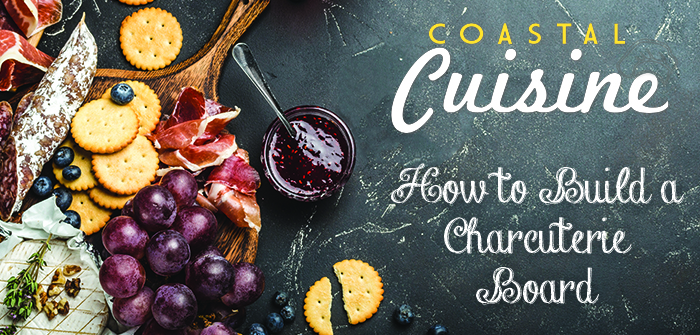Story by Mary Aho
Is there anything more delicious than meat and cheese? More specifically, cured meat. Charcuterie (shahr-cute-uh-ree) can be described as any kind of cured meat. Typically, charcuterie is associated with gourmet and specialty meats prepared in artisanal processes. This practice goes back to the first century AD. It is recorded that the Romans may have been the first to regulate the trade of charcuterie. However, the French have also had some influence starting in the 15th century. Members of the guild, the Charcutiers, produced the traditional range of cooked, salted, and dried meats that are still made and enjoyed today.
Before we dive into how to prepare a charcuterie board, we need to first understand the basics and identify the major types of charcuterie. Rilletes, pate, and mousse are all mixtures of meats that have been cooked and blended. Rabbit, goose, and duck are the most popular types of meat used. While all are a spreadable consistency, rillette has a coarser texture. All these options are best served cold on bread or toast, or even a piece of fruit. Salami is ground meat mixed with spices and occasionally wine, encased like sausage and dried. There are many varieties of salami including chorizo, mortadella, and pepperoni. Salami is usually served sliced or cubed with fruit and cheese. Prosciutto is typically a fatty cut of meat that has been salt cured and dehydrated for months. Although usually made from pork, other meats like duck and lamb have been prepared in the same process and are still considered prosciutto. It is usually sliced very thin due to its dense texture. Prosciutto is very versatile and can be eaten alone, wrapped around fruit or meat and when cooked it gets nice and crispy.
Now that we understand the types of charcuterie, we can start creating an impressive and tasty charcuterie board. When putting together a fantastic charcuterie board, variety is key. With that being said, balancing flavors and textures is also important. For example, if you have a hard salami you want to make sure to have other textures like a spreadable pate. By adding fruit, jams, honey and chocolates you are adding a sweet contrast to all the fatty meats. Having pickles, olives, and nuts can give you salty and spicy flavors. The most important thing to remember when building your board is to create contrast in every bite.
When choosing your cheeses for your charcuterie board, variety is important here as well. You want to make sure to pick one cheese from each category. Soft; like a brie or burrata, semi-soft; like gouda or Havarti, semi-hard; like manchego or gruyere, and hard; aged cheddar or parmigiano Reggiano. Having different textures will not only provide a different mouth feel but also endless flavor combinations. A bread element is usually included in the mix. Toast, baguettes, crackers and bread sticks are some easy and yummy ideas. The last thing you need to make the perfect spread is the board. Typically, a large wooden board will be used but any type of serving tray or slate will do.
If you stick to the basic guidelines, you will be able to create a charcuterie board guaranteed to wow any guest. The sky is the limit when it comes to combinations and presentation. This is where you can let your imagination shine, because there is no right or wrong way. Adding fun extras like dried fruit and mustards give you the freedom to make a custom board. If you are overwhelmed on where to start, pick a certain country and only include items from that region. With this basic knowledge of what it takes to build a charcuterie board, everyone will be wondering when you got your culinary degree… your secret is safe with us.



